Aim: - To study the constructional details of a Pelton Wheel turbine and draw its fluid flow circuit.
Apparatus Used: - Model of Pelton Wheel Turbine.
Theory:
Hydraulic machines are defined as those machines which convert either hydraulic energy (energy possessed by water) into mechanical energy or mechanical energy into hydraulic energy.
Turbines are defined as hydraulic machines which convert hydraulic energy into mechanical energy. Hydraulic turbines are of different types according to specification and Pelton wheel or turbine is one of the types of hydraulic turbines.
Pelton Wheel or Turbine:
The Pelton wheel or Pelton turbine is a tangential flow impulse turbine. The water strikes the bucket along the tangent of the runner. The energy available at the inlet of the turbine is only kinetic energy. The pressure at the inlet and outlet of the turbine is atmospheric. The turbine is used for high heads and is named after L.A Pelton, an American Engineer.
Constructional Details: -
The main parts of the pelton turbine are: -
The amount of water striking the buckets of the runner is controlled by providing a spear in the nozzle. The spear is a conical needle which is operated either by a hand wheel or automatically in an axial direction depending upon the size of the unit. When the spear is pushed forward into the nozzle the amount of water striking the runner is reduced. On the other hand if the spear is pushed back, the amount of water striking the runner increases.
It consists of a circular disc on the periphery of which a number of buckets evenly spaced are fixed. The shape of the buckets is of a double hemispherical cup or bowl. Each bucket is divided into two hemispherical parts by a dividing wall which is known as splitter.
The function of the casing is to prevent the splashing of the water and to discharge water to tail race. It also acts as a safeguard against accidents. It is made of cast iron or fabricated steel plates. As pelton wheel is an impulse turbine, the casing of the pelton wheel does not perform any hydraulic function.
When the nozzle is completely closed by moving the spear in the forward direction the amount of water striking the runner reduces to zero. But the runner due to inertia goes on revolving for a long time. To stop the runner in a short time, a small nozzle is provided which directs the Jet of water on the back of the buckets. This Jet of water is called breaking Jet.
Working of Pelton wheel Turbine:
The water from the reservoir flows through the penstocks at the outlet of which a nozzle is fitted. The nozzle increases the kinetic energy of the water flowing through the penstock by converting pressure energy into kinetic energy. At the outlet of the nozzle, the water comes out in the form of a Jet and strikes on the splitter, which splits up the jet into two parts. These parts of the Jet, glides over the inner surfaces and comes out at the outer edge. The buckets are shaped in such a way that buckets rotates, runner of the turbine rotates and thus hydraulic energy of water gets converted into mechanical energy on the runner of turbine which is further converted into electrical energy in a generator/alternator.
Specifications: -
1. Type – Impulse (free jet) turbine.
2. Type of flow – Tangential.
3. Head – more than 250m (high)
4. Mainly Runner shaft is horizontal in pelton turbine.
5. Specific Speed – 8 to 30 for one nozzle (low)
Up to 50 for more than one nozzle.
Governing mechanism:
Speed of the turbine runner is required to be maintained constant so that the electric generator coupled directly to the turbine shaft runs at constant speed under varying load conditions. With increase in load, the runner speed falls and consequently balls of the centrifugal governor move inwards. Through suitable linkages, the resulting downward movement of the governor sleeve is transmitted to a relay or control valve which admits oil under pressure to a servomotor. The oil exerts a force on the piston of the servomotor, and that pushes the spear to a position which increases the annular area of the nozzle flow passage. Quantum of water striking the buckets is then increased and the normal turbine speed is restored.
Viva Questions
EXPERIMENT NO 2
Aim: - To Study the constructional details of the Francis Turbine (Reaction turbine) and draw its fluid flow circuit.
Apparatus used: - Model of Francis Turbine.
Formula Used: -
Where r = Density of water
Q = Discharge of water
Vw1= Whirl velocity of water at inlet
U1= Runner velocity
Vf1= Velocity of flow at inlet
H= Net head
Theory: - Reaction Turbine: - In this type of turbine there is a gradual pressure drop and takes place continuously over the fixed and moving blades or over guide vanes and moving vanes. The function of the guides’ vanes is that they alter the direction of water as well as increases its velocity. As the water passes over the moving vanes its kinetic energy is absorbed by them.
Francis Turbine: - The inward flow reaction turbine having radial discharge at outlet is known as Francis turbine, after the name of J.B Francis an American engineer who in beginning designed inward radial flow reaction turbine. In the modern Francis turbine, the water enters the runner of the turbine in the radial direction and leaves in the axial direction at the outlet of the runner. Thus the modern Francis turbine is a mixed flow type turbine.
Constructional details:-
The main parts of the Francis turbine are: -
increasing area is called draft tube. The draft tube, in addition to serve a passage for water discharge, has the following two purposes also.
Specifications:-
Governing Mechanism:-
The governing mechanism changes the position of guide blades to affect a variation in the water flow rate in the wake of changing load condition of the turbine. When the load changes, the governing mechanism rotates all guide blades about their axis through the same angle so that the water flow rate to the runner and its direction essentially remain the same at the all passages between any two consecutive guide vans. The penstock pipe feeding the turbine is often fitted with a relief valve, also known as the pressure regulator. When guide vanes are suddenly closed, the relief valve opens and diverts the water direct to tail race. The simultaneous operation of guide vanes and relief valve is termed as double regulation.
Viva Questions:-
EXPERIMENT NO 3
Aim: - To Study the constructional details of a Kaplan Turbine and draw its fluid flow circuit.
Apparatus Used: - Model of Kaplan Turbine.
Theory: - Axial flow Turbine: - 1. Kaplan Turbine (Adjustable blades)
2. Propeller (Blades are fixed)
Kaplan Turbine: - Kaplan Reaction turbines are axial flow turbines in which the flow is parallel to the axis of the shaft. They are low head, high discharge turbine. In this water turn at right angles between the guide vanes, runner & then flow parallel to the shaft. It is inward flow reaction turbine. The flow was along the radius from periphery to the centre of the runner. (From outer dia to the inner dia of runner). It is capable of giving high efficiency at overloads (up to 15-20%), at normal loads (up to 94%). The runner of this turbine is in the form of boss or hub which extends in a bigger dia. Casing with proper adjustment of blades during running. The blade angles should be properly adjusted so that water enters & flow through the runner blades with out shock.
Constructional details:-
Chamber, is provided between the guide vanes and the runner. In this chamber, the flow turns by 90° & move as a free vortex i.e without the aid of any external torque. The radial component changes into axial component due to the guidance from the fixed housing.
Specifications:-
Viva Questions:-
EXPERIMENT NO 4
Aim: - To study the working & constructional details of Hydro-power plant (H.P.P)
Apparatus Used: - Model of Hydro-power plant.
Theory: - Hydro-power Plant can be classified as follows:-
(a). Run-of-River plants (R.P.P) : are low head plant
(i) Run of River plants with pondage
(ii) Run of River plants without pondage
(b). Storage Reservoir Plants (S.R.P): - are made for generating power and also for controlling the floods, irrigation purpose and for fishing etc. They are called multipurpose projects, e.g. Bhakra Nangal, Damoder Valley projects.
(c). Pump Storage Plants (P.S.P): - Also called reservoir turbine with high efficiency used for power head race level.
(d). Peak Load Plants (P.L.P): - Work during peak load hours.
Based on availability of Head:
(a). Low Head Plant (L.H.P.): - Head <45 m, Kaplan & Propeller type turbine are used
(b). Medium Head Plant (M.H.P): - Head =45-250m, fore bays, surge tanks are used to avoid the effect of water hammer (W.H).
(c). High Head plant (H.P.P).
Constructional details or components of hydro power plant are: -
cleaning device is also provided to remove the debris from the trash racks. (iv). Heating arrangements to melt the ice of the mountains at the inlet.
(a). A tunnel has to be cut through a hill if it comes between the reservoir & power house.
(b). Open channel: - Are to be provided when the distance of the water storage & the power house is considerable.
(c) : - Penstock are the steel or reinforced concrete pipes used in the last stage of the water travel from reservoir to the power house.
Surge Tanks: - Also act as a small reservoir for the water to the turbine. When the load on the turbine is reduced, water has to be restarted but it takes time to do so; the excess flow of water is temporarily stored in the surge tank & the level of the water in the surge tank becomes higher then the average. When the load on turbine increases, the increased supply of water is made partially by the direct flow of water and partially be the surge tank containing the water. It also avoids the water hammer effects. They are must for high and medium head plants and should be located as close to the turbine as possible. It is a cylindrical open tapped tank and the normal level of water in it. To be at the level of reservoir minus the head losses in transition from the reservoir to the surge tank. To reduce the height of the surge tank, it is usually located at the junction of penstock and the pressure channel.
Viva Questions:-
EXPERIMENT NO 5
Aim: - To study the constructional details and working of Hydraulic Ram.
Apparatus Used: - Model of Hydraulic Ram.
Theory: - Hydraulic System: - is an arrangement to transmit forces and energy through an incompressible fluid.
They are of two types:-
(a). Pumping Unit: - That acts as a power source to develop the hydraulic pressure from mechanical work- Usually it is a rotary or a reciprocating pump.
(b). Transmission line or passage: - Through which power and energy are to be transmitted from the place of production to the place of its necessity.
(c). Hydraulic motor: - To reconvert the hydraulic pressure into mechanical work. Again this can be of rotary or reciprocating type in the form of cylinder & piston. Piston in the cylinder is moved by the fluid pressure providing useful work. e.g. Hydraulic press, crane, lift etc.
2. Hydro Kinematics System: - In this transmission is due to change in the velocity and the direction of fluid flow. With a negligible change in the pressure of the fluid. It has two main elements: -
(a). Pump- impeller driven by the driving shaft (centrifugal pump).
(b). Turbine Runner to run the driven shaft: - There is circulation of oil from the pump impeller to the runner that transmits power. For e.g. Hydraulic Ram: - It is a pump which raises small quantity of water to a greater height, if large qty. of water is available at a lower height without using any external power.
Constructional details: - its main parts are: -
Supply line, Supply tank, Waste valve, Delivery valve, Valve chamber, Delivery pipe, Delivery tank, Air vessel, Non-return valve, Drain cock, Pressure gauge.
Working principle: - It works on the principle of water hammer effectors inertia force of water in a pipe line. When a flowing fluid is brought to rest suddenly a rise of pressure occurs, which can be utilized to raise a portion of water to a higher level. It does not require any external power for its operation.
It consist of a valve chamber fitted with two valves, a wattle valve & a delivery valve, both being none return valves. The delivery valve opens into an Air vessel to carry the air compressed. A delivery pipe is connected to the air vessel to carry the water to a delivery tank. A supply pipe connects the available water source to the valve chamber.
At a particular moment assume that the delivery valve is closed and the waste valve is open. Water flows down the supply pipe in to the valve chamber and then through the waste valves into waste water tunnel. As the velocity of water in the pipe in creases, the dynamic pressure on the underside of the waste valve becomes high. This closes the waste valve which was open due to its own weight. With the sudden closure of the waste valve, the velocity reduces to zero and the pressure in the valve chamber. The high pressure of water forcibly opens the delivery
EXPERIMENT NO 6
Aim: - To study the constructional details of a centrifugal pump and draw its characteristics curve.
Apparatus used: - Centrifugal pump test rig.
Theory: - The hydraulic machine which converts the mechanical energy in to pressure energy by means of centrifugal force acting on the fluid is called centrifugal pump.
The centrifugal pump acts as a reverse of an inward radial flow reaction turbine. This means that the flow in centrifugal pump is in the radial outward directions. The centrifugal pump works on the principle of forced vertex flow which means that when a certain mass of liquid is related by an external torque, the rise in pressure head of the rotating liquid takes place. The rise in pressure head at any point of the rotating liquid is proportional to the square of the tangential velocity of the liquid at that point. Thus at the outlet of the impeller radius is more, the rise in pressure head will be more and the liquid will be discharged at the outlet with a high pressure head. Due to this pressure head, the liquid can be lifted to a high level.
Constructional details:-
Main part of a centrifugal pump:-
1. Impeller:-The rotating part of a centrifugal pump is called “Impeller”. It consists of a series of backward curved vanes. The impeller is mounted on a shaft which is connected to the shaft of an electric motor.
2. Casing: - The casing of a centrifugal pump is similar to the casing of a reaction turbine. It is an air-tight passage surrounding the impeller and is designed in such a way that the kinetic energy of the water discharged at the outlet of the impeller is converted in to pressure energy before the water leaves the casing and enters the delivery pipe. The following three types of casing are commonly adopted:-
(i) Volute casing
(ii) Vortex casing
(iii) Casing with guide blade
Formulae used:-
Inlet pressure head = P1m
Discharge pressure head = P2m
Flow rate = Qm3/s
In centrifugal pump, we take
Manometer head H = Total head at inlet- Total head at outlet
Datum head = Z2m
Total head across pump H = (P1-P2) +Z2
Torque T = (load. arm distance)
Input power P = (2π. speed in r.p.s. T) Watts
Water power Po = (ρ. g. H .Q) Watts
Efficiency ή % = Water power /Input power .100s
Observation table:-
Position of delivery pressure gauge (datum head) = Z2m
Arm distance = m
ρg = 9810
Area of collecting tank, a = cm2
Sl no |
Discharge measurement |
Discharge |
Pump speed |
Suction head |
Delivery head |
Manometric head |
Load |
Torque |
Water power |
Input power |
h % |
||
Initial h1 m |
Final |
Time |
|||||||||||
|
|
|
|
|
|
|
|
|
|
|
|
|
|
Procedure:-
Result:-
Viva Questions:-
EXPERIMENT NO 7
Aim: - To study constructional details of a centrifugal compressor.
Apparatus: - Model of centrifugal compressor.
Theory: - The centrifugal compressor are used to apply large quantity of air at low pressure, the compressor consist of a rotating impeller diffuser and casing. The impeller consists of a disc on which radial blades are attached. The impeller of a centrifugal compressor can be run at a speed of 20,000 to 30,000 rpm. The diffuser is other important part of compressor which surrounds the impeller and delivery passage for air flow. The air coming out from the diffuser is other important part of compressor which surrounds the impeller and delivery passage for air flow. The air coming out from the diffuser is collected in casing and then taken out from outlet. The air enters with low velocity and atmospheric pressure. The air moves radially outwards passing through the impellor increases the momentum of air flowing through it. Causing rise in pressure and temperature of air. The air leaving due impeller enters diffuser where its velocity is reduced by providing more cross-sectional for flow. The part of K.E of air if converted into pressure energy and pressure of air for flow. The part of K.E is converted into pressure energy and pressure of air further increased nearly half of the total pressure rise is achieved by impellor and remaining half in diffuser. A pressure ratio of ‘4’ can be achieved in a single stage compressor for high pressure ratio of 12:1 is possible with multistage compressor. The change of pressure and velocity of air shown. The impeller which are generally used are can of the two type and subjected to equal and axial forces in opposite direction which is advantage of single eye impellor.
Viva Questions:-
EXPERIMENT NO 8
Aim:- To study the constructional details of gear pump and draw its characteristic curve.
Apparatus Used:- Model of oil gear pump.
Theory:- The gear pump is a rotary pump in which two gear mesh to provide the pumping action. This type of pump is mostly used for cooling water and pressure oil to be supplied for lubrication to turbine, machine tool etc. Although the gear pump is rotating machinery yet it action on liquid to be pumped is not dynamic it nearly displaces. The liquid from one side to other. The flow of liquid to be supplied is continues and uniform.
Constructional details:- A gear pump has following parts:-
Casing:- The function of casing in this type of pump is only to make the liquid which is to be transferred in contact with gear wheel. The width of gear wheel casing also contains bearing in its body.
Gear wheel:- In gear wheel pump there are two identical intermeshing gear working in a fine clearance. One of the gear is keyed to shaft know as driving shaft. The other gear revolves due to driving shaft. These two gears are constructed with a definite clearance. The space between gear teeth and casing is filled with oil. The oil is carried between the gears from suction pipe to delivery pipe.
Suction pipe:- These pipe are in circular shape connect the gear to suction and delivery.
Viva Questions:-
EXPERIMENT NO 9
Aim:-To study constructional details of reciprocating pump and draw its characteristic curve.
Apparatus Used:- Pump, Pipe work system with all necessary control pipe or valve, Collecting tank, Pressure gauge located on suction and discharge side.
Theory:- The reciprocating pump is positive displacement pump i.e. it operates on the principles of actual displacement or pushing of liquid by a piston or plunger that executes a reciprocating motion in a closely fitted cylinder. The liquid is alternatively drawn from the pump and filled into suction side of the cylinder. The liquid fed to discharge side of the cylinder and emptied to the delivery pipe. The piston or plunger gets its reciprocating motion by means of a crank and connecting rod mechanism.
Working:- To start with when the crank angle θ is zero or the piston is towards extreme left as the crank moves from inner dead to outer dead centre i. e. from θ=0o to Ө=180 . The piston moves from extreme left to extreme right end. This movement of piston called backward stroke. So during the backward stroke volume of air in the cylinder increase, resulting fall in pressure or partial vacuum. The air in suction pipe being at atmospheric pressure rush to the cylinder. This by the end of backward stroke air in the suction pipe and the cylinder is rearranged and started otherwise partial pressure of some degree is created .During the forward stroke of the piston as the crank moves from θ = 180o to θ =360o.The air in cylinder is forced out through the delivery pipe. Thus after a few backward stroke and forward stroke sufficient partial vacuum is created. A stage come in backward stroke, the liquid due to the atmospheric pressure existing on the surface is sucked in and forced out during the backward stroke, the liquid sucked is forced out through the non return delivery valve it is called discharge stroke or delivery stroke.
From above we find that pump has a capacity to create partial vacuum resulting in the suction of the liquid by itself property is called self priming.
It may be observed that a single acting single cylinder pump liquid is swept and only once in one revolution of the crank where is in double acting, it is swept twice for each revolution of the crank.
Observation table:- Area of collecting tank, a = cm2
ρg = 9810
Sl no |
Discharge measurement |
Discharge |
Delivery head |
Water power |
Input power |
h % |
||
Initial h1 m |
Final |
Time |
||||||
|
|
|
|
|
|
|
|
|
Procedure:-
1. Note down the area of collecting tank
Result:-
Viva Questions:-
EXPERIMENT NO 10
Aim:- (a) To verify the momentum equation experimentally.
(b) Comparison of change in force exerted due to shape of the vane. (flat, inclined or curved)
Apparatus Used:- Collecting tank, Transparent cylinder, Two nozzles of dia 10 mm & 12mm, Vane of different shape (flat,inclind or curved)
Theory:- Momentum equation is based on Newton’s second law of motion which states that the algebric sum of external forces applied to control volume of fluid in any direction is equal to the rate of change of momentum in that direction. The external forces include the component of the weight of the fluid & of the forces exerted externally upon the boundary surface of the control volume. If a vertical water jet moving with velocity is made to strike a target, which is free to move in the vertical direction then a force will be exerted on the target by the impact of jet, according to momentum equation this force (which is also equal to the force required to bring back the target in its original position) must be equal to the rate of change of momentum of the jet flow in that direction.
Formula Used:-
F'=ρ Q v(1-cosβ)
F'=ρ Q2 (1-cosβ) as v=Q/a
Where F' =force (calculated)
ρ = density of water
β=angle of difference vane
V =velocity of jet angle
Q =discharge
A =area of nozzle ( π/4d2)
F = ρQ2/a
(ii) for hemispherical vane β=180o
for % error =F- F'/ F'x100
F = 2 Q2/a
F = Force (due to putting of weight)
Procedure:-
1. Note down the relevant dimension or area of collecting tank, dia of nozzle, and density of water.
2. Install any type of vane i.e. flat, inclined or curved.
10.This procedure can be repeated for different type of vanes and nozzle.
Precautions:-
1. Water flow should be steady and uniform.
2. The reading on the scale should be taken without any error.
3. The weight should be put slowly & one by one.
4. After changing the vane the flask should be closed tightly.
Viva Questions:-
EXPERIMENT NO. 11
Aim: - To draw the following performance characteristics of Hydraulic turbine- constant head, constant speed and constant efficiency curves.
Equipment: - Model of Pelton Turbine.
Theory: - Characteristic Curves: - Characteristic curves of hydraulic turbines are the curves, with the help of which the exact behavior and performance of the turbine under different working conditions can be known. These curves are plotted from the results of the tests performed on the turbine under different working conditions.
Out of the above six parameters, three parameters namely speed (N) Head (H), Discharge (Q) are independent parameters.
Out of the three independent parameter (Power (P), Overall efficiency (h0), Gate opening) one of the parameter is kept constant (say H) and variation of the remaining two independent variables (say N & Q) are plotted and various curves are obtained. These curves are called characteristic curves. The following are important characteristic curves of a turbine.
Observation table:-
Dia of nozzle =
Mass density of water ρ =
Area of collecting tank =
Area of nozzle =
Horizontal flat vane
When jet is not running, position of upper disk is at =
SNO |
Discharge measurement |
Balancing |
Theoretical |
Error in % |
||||
Initial |
Final |
Time |
Discharge |
Mass |
Force |
|||
|
|
|
|
|
|
|
|
|
|
|
|
|
|
|
|
|
|
|
|
|
|
|
|
|
|
|
Inclined vane
When jet is not running, position of upper disk is at =
Angle of inclination β = 450
SNO |
Discharge measurement |
Balancing |
Theoretical |
Error in % |
||||
Initial |
Final |
Time |
Discharge |
Mass |
Force |
|||
|
|
|
|
|
|
|
|
|
|
|
|
|
|
|
|
|
|
|
|
|
|
|
|
|
|
|
Curved hemispherical vane
When jet is not running, position of upper disk is at =
SNO |
Discharge measurement |
Balancing |
Theoretical |
Error in % |
||||
Initial |
Final |
Time |
Discharge |
Mass |
Force |
|||
|
|
|
|
|
|
|
|
|
|
|
|
|
|
|
|
|
|
|
|
|
|
|
|
|
|
|
Precautions:-
1. Water flow should be steady and uniform.
2. The reading on the scale should be taken without any error.
3. The weight should be put slowly & one by one.
4. After changing the vane the flask should be closed tightly.
Viva Questions:-
Source: https://csvtuqb.files.wordpress.com/2014/10/fluid_machines_lab_vsem.doc
Web site to visit: https://csvtuqb.files.wordpress.com
Author of the text: indicated on the source document of the above text
Introduction
The fluid machines covered on this page are primarily hydraulic machines.
The notes below only relate to the general principles involved - more specific notes and information on steam and pneumatic machines, are provided on the linked pages below.
A fluid machine is a device for converting energy held in a fluid ( dynamic or potential ) into mechanical energy or it can convert mechanical energy into fluid based energy.
Notes on Pump Types and Operation
Notes on Air Compressors and Motors
Notes on Steam Turbines
Notes on pneumatics and hydraulics
The main types of fluid machines are listed as
Turbines and pumps..
A turbine directly converts fluid energy into rotating shaft energy.
If the fluid motion is converted, initially to reciprocating mechanical motion the machine is an engine e.g and internal combustion engine or a steam engine ).
A machine for converting mechanical energy into fluid flow is called a pump...
Compressors or Fan ..
If the machine converts mechanical energy to increase the potential energy of a compressible fluid by increasing its pressure the machine is called a compressor. If the machine is primarily provided to increase the kinetic energy of a compressible fluid e.g. air, the machine is a fan. With a fan or blower the pressure head developed is usually relatively small and fluid calculations can often be done assuming the fluid is incompressible.
Positive Displacement Machines ..
A pump can be a positive displacement machine or a rotodynamic machine Ref. Pumps ..Positive displacement machines are designed such that there is virtually zero fluid slippage in the energy transfer process. The general principle of these type of pumps is that fluid is drawn into a chamber at a low pressure. The inlet to the chamber is closed and the outlet is opened, and the fluid is then forced out of the chamber by reducing its volume.
The type of pump can be used to generate very high pressures in a compact mechanical envelope. The main disadvantage is that the operation is an intermittent one resulting in a high level of pressure fluctuation throughout the operating cycle.
Rotodynamic Machines ..
All rotodynamic machines have a rotating component through which the fluid passes. In a turbine this is called the rotor which has a number of vanes or blades. The fluid passes through the blades and drives the rotor round transferring tangential momentum to the rotor. In a pump the tangential motion of the rotor as it rotates results in an increase in the tangential momentum of the fluid . This increase in kinetic energy is converted to pressure by decelerating the fluid in the discharge route from the pump. In a turbine the fluid passes over /through the impeller and loses energy (momentum and pressure) the energy being transferred to the rotor.
Rotodynamic machines are smooth and continuous in action with a consequent pulsation free flow from pumps and smooth rotation from turbines. In the event of pump discharge flow being suddenly stopped there are no high shock loads. Positive displacement machines can easily be damaged if a discharge valve is suddenly closed. Rotodynamic pumps are ideal for high flow low discharge head duties and provide compact reliable solutions.
Symbols
A = Area (m2) a = Speed of sound (m/s) CV = Coefficient of Velocity for nozzle. ρ = density (kg/m3) ρ1 = density at inlet conditions(kg/m3) g = acceleration due to gravity (m/s2 ) ε = Expansion factor h = fluid head (m) L = Pipe length (m ) m = mass (kg) m = mass flow rate (kg/s).. P1 = Inlet fluid pressure (gauge) (N /m2 ) P2 = Outlet fluid pressure (gauge) (N /m2 ) P1 = Inlet fluid pressure (abs) (N /m2 ) P2 = Outlet fluid pressure (abs) (N /m2 ) P - Absolute pressure (N /m2 ) pgauge - gauge pressure (N /m2 ) patm - atmospheric pressure (N /m2 ) |
p s= surface pressure (N /m2 ) |
Reciprocating Pumps
The general principles of operation of the reciprocating pump is illustrated by the figure below. The motion of the piston is such that it is driving the fluid out of the cylinder through the one way valve into the upper tank. The fluid, in this case, is incompressible and the flow rate is almost totally dependent on the velocity of the piston. As the driving arm continues to rotate the piston commences to move outwards. Reverse flow in the discharge line results in the discharge valve closing and fluid being drawn up from the lower reservoir causes the suction valve to open. Fluid is therefore drawn into the cylinder from the lower reservoir.
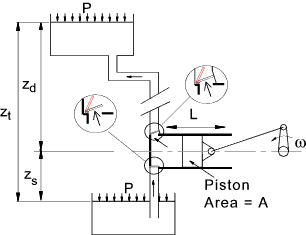
The design of the inlet and outlet valves as shown are simple flap valves. Other valve types include ball valves and poppet valves. The valves may be gravity/flow operated or spring operated or mechanically linked to the position of the piston.
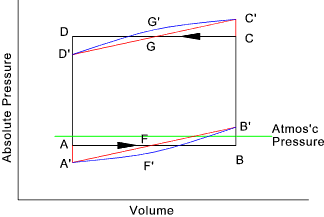
A plot showing the absolute pressure against piston displacment volume is shown above. The piston has an area A and the pressure within the cylinder is p.
The work done by the piston in the discharge stroke and on the piston in the suction stroke is F dx. = p A dx. = p dV. The area enclosed within the pressure- volume curve therefore represents the work done by the cylinder in one cycle.
A-B-C-D represents the operating cycle with no losses. A'-F-B'-C'-G-D' is the curve allowing for the inertia of the fluid i.e. the fluid has to be accelerated and the start of the stroke and slowed at the end of the stroke. A'-F'-B'-C'-G'-D' also includes for the friction in the piping and the inlet and outlet valves- this will be greatest at the middle of the stroke when the velocity of the piston is highest ( due to the motion of the driving arm). Note: the differences between the ideal and real plots are exaggerated. The deviations from the no-loss operating cycles are clearly more pronounced as the pump speed increases
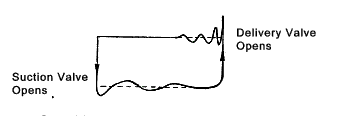
The design of the valves can have a significant effect on the efficiency of operation of the piston pump. Some systems have valves which are large compared to the volume of the cylinders. Spring loaded lift valves working at relatively high frequencies can bounce and the effect on the operating curve can be significant as shown in the figure above.
The motion of the piston (plunger) and consequently the output flow is sinusoidal. In practice it is desirable to have a smooth continuous flow. There are a number of methods of increasing the delivered flow including. Using double acting pumps and using mult-cylinder pumps. These arrangements are shown below.
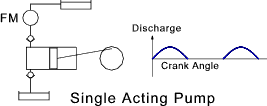
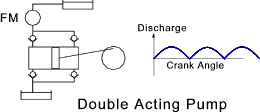
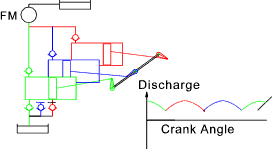
The inflows and the outflows can be further smoothed and the pulsations can be largely eliminated by installing surge tanks as shown below
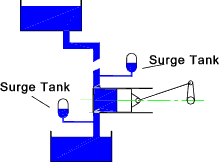
In practice the discharge resulting from each cycle is slightly different from the volume displaced by the piston (plunger). This is because a certain leakage takes place and the valves do not open and close instantly. This is identified by using a coefficient of discharge. The coefficient of discharg Cd is the Discharge per cycle / The Swept volume. The percentage slip is also used to identify this source of inefficiency.
% Slip = 100 .(1 - Cd ) = 100 {[ Swept Volume - Discharge volume/stroke] / Swept Volume }
Turbines
Unlike the reciprocating positive displacement pumps, which work primarily under hydrostatic conditions, turbines transfer energy to the fluid under hydrodynamic conditions by converting the kinetic energy of the blades to kinetic energy of the fluid or vice versa. In radial flow machines the fluid flows mainly in the plane of the rotation. The fluid enters the machine at one radius and exits the machine at a different radius. This type of machine includes the Francis turbine and the centrifugal pump. In axial flow machines the fluid moves generally parallel to the axis of the pumps. If the flow is partly radial and partly axial the machine is said to be a mixed flow machine. A rotodynamic pump can often be used as a motor. This option is often used for hydraulic pump storage systems
For any turbine the energy in the fluid is initially pressure energy. For water turbines, this pressure energy is developed as a head of fluid in a high level reservoir. For steam turbines the pressure is developed by the addition of heat in boilers..
The impulse turbine has one or more fixed nozzles. The nozzles turn the pressure energy into kinetic energy as high velocity jets of fluid. These jets then impinge on the moving blades of the runner where the fluid loses almost all of its kinetic energy and the momentum is transferred to the blade. A typical impulse turbine is the pelton wheel
The reaction turbine fluid transfers its energy by tangential slippage across the blades literally pushing the blades sideways out of its path. The energy transfer is a gradual process, the fluid loses it kinetic energy progressively. The fluid literally fills all of the passages through turbine blades. A typical reaction turbine is the steam or gas turbine.
Impulse Turbines - Pelton Wheel.... Reference Jets on moving plates
In a typical pelton wheel, as shown, below the fluid kinetic energy is transferred to the rotating wheel according to the momentum equation. The fluid velocity, momentum, and the resulting force on the buckets are all vector quantities and the system is best analysed using vectors.
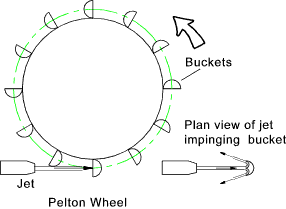
The velocity of the fluid leaving the jet is given by
![]()
CV = coefficient of velocity (between 0,97 and 0,99)
H is the net head at the nozzle = (HT - Hf)= (the total head due gravity - The friction head which is generally negligible.)
The vector diagram for the fluid impinging on the bucket is shown below. Each bucket rotates slightly while it is in the path of the jet but this does not have a significant effect on the analysis.
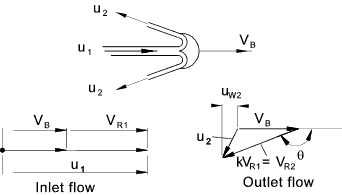
The outlet flow flow from the bucket is split but the split is considered symmetrical and therefore one path only needs to be considered.
The velocity of the fluid approaching the bucket = u1.
The velocity of the bucket = VB.
The velocity of the approaching fluid to relative the bucket velocity is VR1 = u1 - VB
The velocity of the outlet fluid relative the bucket velocity is VR2 = k.VR1 (k being a friction loss factor)
The velocity of the fluid in the direction of bucket movement -> is the whirl velocity.
The inlet whirl velocity = u1
The outlet whirl velocity uw2 is simply VB - VR2(cos (π - θ)
The radius of the wheel is r.
The change in whirl component of the fluid velocity = ΔuW = u1 - [VB-VR2 (cos (π - θ)] = VR1 - k.VR1cos (π - θ)
Therefore..
![]()
The force( F )driving the bucket round is equal to the rate of change of momentum of the fluid F = ρ QΔuW.
The torque driving the wheel = F r
The power from the wheel is F r ω = Q ρ ΔuW VB
The rate of kinetic energy arrival in the fluid = [ Q ρ u 12 ] /2
The efficiency of the Pelton Wheel is therefore expressed as follows
![]()
It can be easily proved that the maximum efficiency of the Pelton wheel is when VB = u1 / 2... (Assuming the friction factor is constant ). The above analysis is an idealised one. In practice there will be friction losses reflect in the value of k. There will be losses as the buckets move into and out of the line of the jet, and there will be windage losses as the wheel rotates. The graph below shows the effect of these losses on the efficiency curve
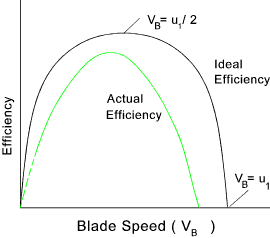
The principle methods of controlling the speed of the Pelton wheels is by using special valves associated with the nozzles or by diverting the jet away from the buckets or by simply starting and stopping the flow.
Pelton wheels are more suitable for operating under large heads...
Further notes on impulse turbines as related to steam as a fluid are found at Steam Turbines -Impulse Blading
Reaction Turbines - Francis Turbine - Centrifugal Pump ....
The reaction turbine is completely immersed in the fluid and the energy is converted from fluid to mechanical motion , and vice versa, gradually as the fluid passes over the blades. In a reaction turbine the fluid (water) supplied to the rotor (runner) possesses part pressure energy and part and kinetic energy . Both types of energy ar converted into work in the runner, resulting in a drop of the pressure and absolute velocity of the fluid. A typical reaction turbine is the Francis Turbine which is generally arranged with a vertical shaft.
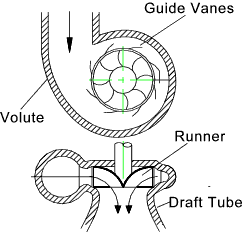
This type of turbine is a mixed flow type - the fluid entering the runner in a radial direction and exiting the runner axially downwards.
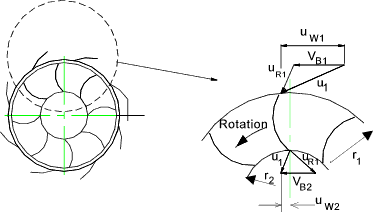
The only movement of the runner blades is in the circumferential direction and therefore only circumferential fluid force components result in work transfer.
The fluid velocity at the feed into the rotor tangential to the rotor is uW1.
The fluid velocity leaving the rotor in the tangential direction is uW2.
Considering a particle of fluid δm at the rotor inlet . This has a tangential momentum uW1 δm and an angular momentum uW1 r1 δm.
The mass particle has a angular momentum on leaving the rotor of uW2 r2 δm.
If the total mass flow rate is m and considering a small part of this flow δm.
The rate of momentum entering the rotor is uW1 r1 δm and the rate of momentum leaving the rotor is uW2 r2 δm. This assumes r1 , r2, uW1 and uW2 are constant over the area over which δm flows.
The total rate of fluid momentum loss across the turbine is equal to the torque acting on the fluid which is
![]()
By application of Newtons third law ( for revery action there is a equal and opposit reaction) the fluid exerts the same torque , in reverse on the rotors.
![]()
The above equation is known as Euler's equation and identifies a fundamental relationship for all forms of rotodynamic machinery including turbines, pumps, fans and compressors. It applies to rotors and stators.
If the products uW1 r1 and uW2 r2 are each constant at the inlet and outlets (vortex free) then the equation simplifies to
![]()
If the value of Tr is positive and the rotor is rotating in the same direction as the fluid then the fluid does work on the rotor and the machine is operating as a turbine. If the fluid resists rotation of the rotor or impeller and Tr from the above equation is negative then the machine is operating as a pump.
The rate at which shaft work is done on the rotor (power) is Tω .

Now if the turbine shaft work rate is divided by the mass flow rate the work done per unit mass ( w ) results
![]()
Referring to the figure below the net Head (H) across the Francis machine is the total head between the supply reservoir and the tail water , minus the pipe friction losses (hf ) and the kinetic head of the fluid at outlet of the draft tube. Therefore
![]()
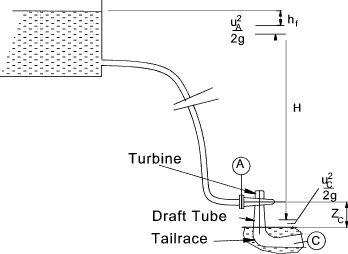
The energy available per unit mass = Hg
Therefore the efficiency of the Francis Turbine is
![]()
Source: http://www.worldcolleges.info/sites/default/files/enggnotes/roto_dynamic_machines.doc
Web site to visit: http://www.worldcolleges.info
Author of the text: indicated on the source document of the above text
If you are the author of the text above and you not agree to share your knowledge for teaching, research, scholarship (for fair use as indicated in the United States copyrigh low) please send us an e-mail and we will remove your text quickly. Fair use is a limitation and exception to the exclusive right granted by copyright law to the author of a creative work. In United States copyright law, fair use is a doctrine that permits limited use of copyrighted material without acquiring permission from the rights holders. Examples of fair use include commentary, search engines, criticism, news reporting, research, teaching, library archiving and scholarship. It provides for the legal, unlicensed citation or incorporation of copyrighted material in another author's work under a four-factor balancing test. (source: http://en.wikipedia.org/wiki/Fair_use)
The information of medicine and health contained in the site are of a general nature and purpose which is purely informative and for this reason may not replace in any case, the council of a doctor or a qualified entity legally to the profession.
The texts are the property of their respective authors and we thank them for giving us the opportunity to share for free to students, teachers and users of the Web their texts will used only for illustrative educational and scientific purposes only.
All the information in our site are given for nonprofit educational purposes